Google Nexus 4 and Nexus 10 Performance Preview
by Anand Lal Shimpi & Brian Klug on November 2, 2012 11:00 AM ESTGPU Performance
This section is particularly exciting because it's our first look at ARM's new Mali-T604 GPU in our standard mobile 3D performance suite. We've already seen the Nexus 4's Adreno 320 in action, but the Nexus 10's behavior here should be interesting to see.
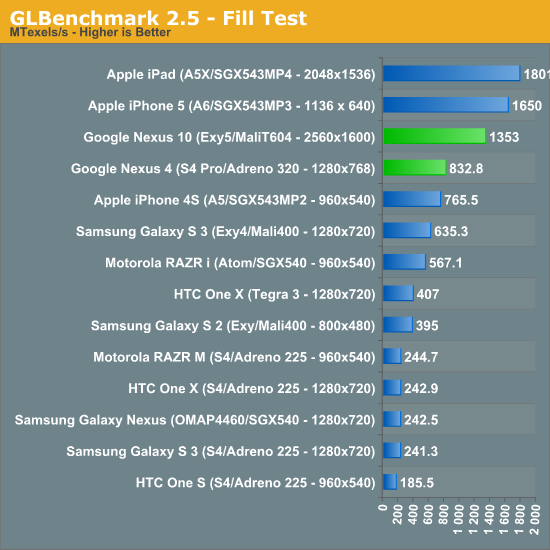
As far as raw fillrates are concerned, both Nexus devices do quite well here at their native resolutions. The iPad and iPhone 5 are both quicker, but we're still good gains over the previous generation of hardware - particularly for the Mali-T604. Compared to the Mali-400MP4 in the Galaxy S 3, we're seeing more than 2x the performance out of ARM's latest GPU.
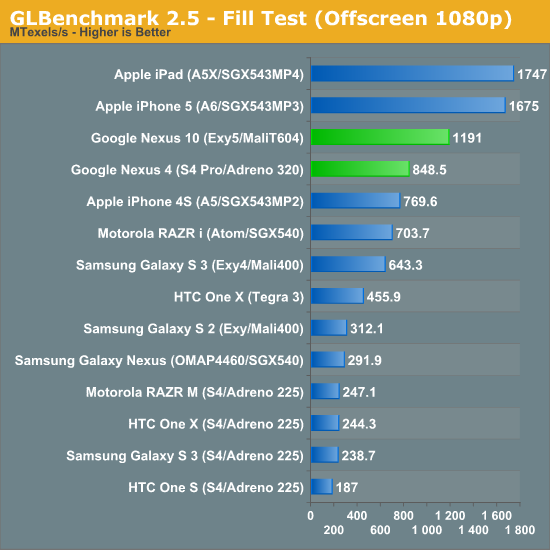
At normalized resolutions the standings don't really change.
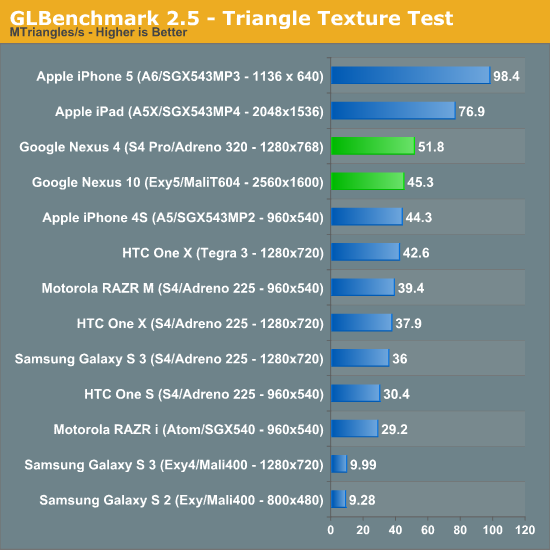
The T604 is ARM's first unified shader architecture, which gives it far more balanced pixel/vertex shader performance. The result is a more than 4x increase in triangle throughput compared to the Mali 400MP4. It's not enough to give the Nexus 10 the edge over the latest Apple devices, but it's a huge improvement over where ARM was in the previous generation. The Adreno 320 continues to be quite strong here as well.
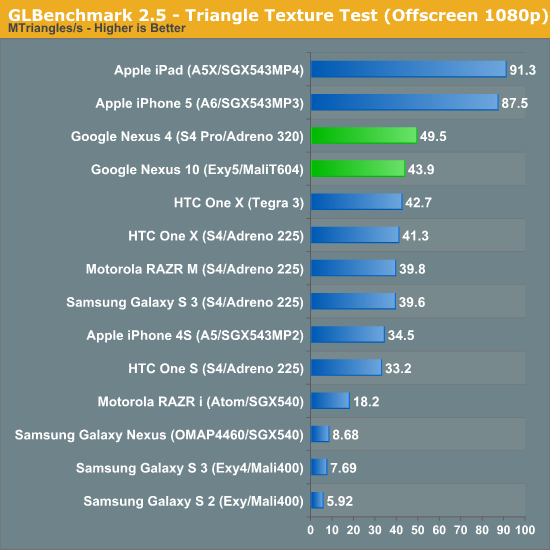
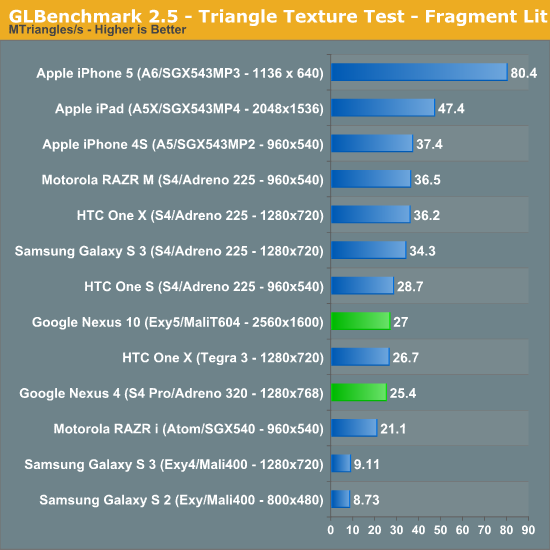
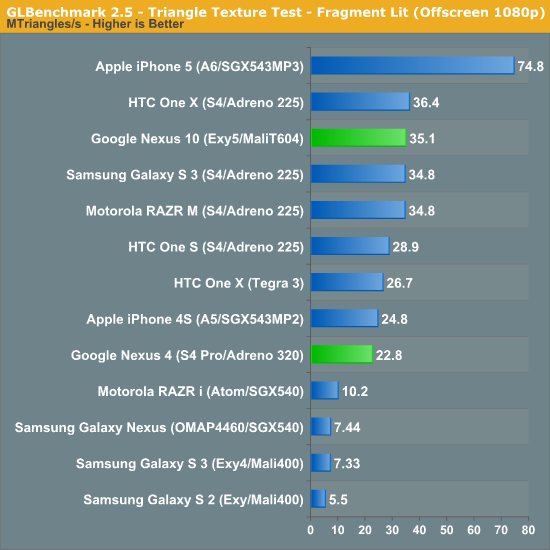
Once again we're seeing huge gains for the Mali-T604 compared to the Mali-400MP4. The Adreno 320 in the Nexus 4 actually performs worse than the Adreno 225 in older devices, possibly due to thermal throttling we saw on the Nexus 4 sample during periods of heavy load.
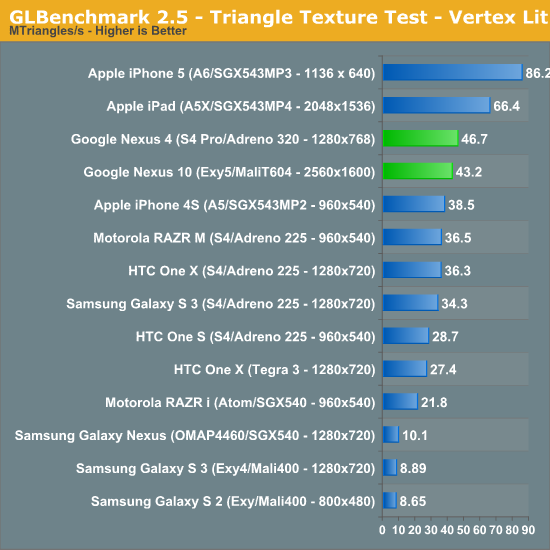
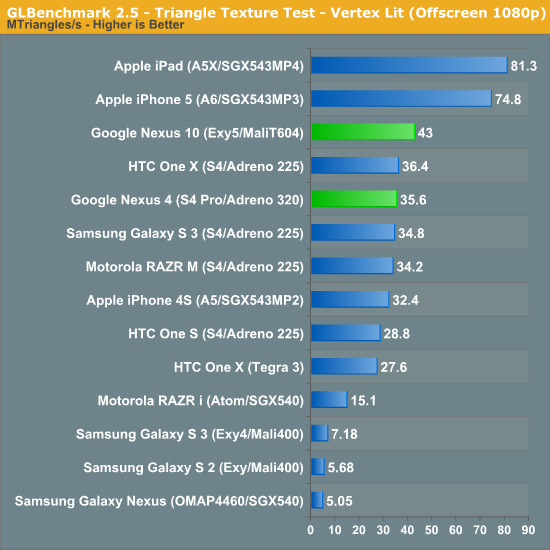
ARM shows the biggest gains here once again thanks to its move to a unified shader architecture. The Adreno 320 does ok here but it's really no better than the 225, I suspect there is some thermal throttling happening on the device.
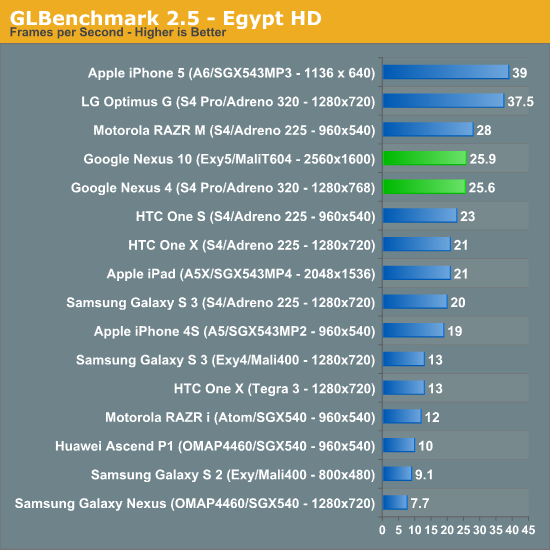
At native resolutions, the Nexus 10 and NExus 4 are both capable of putting out decent frame rates in Egypt HD. What this data tells us is they'll likely be able to run current and even some future titles, at native res, at 30 fps without much of an issue.
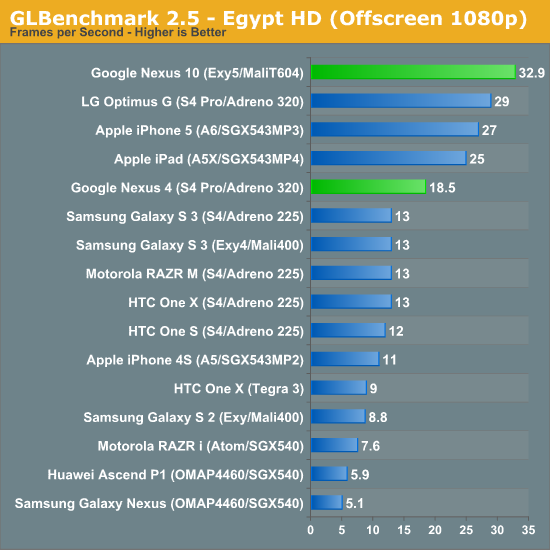
Normalize resolution and the Mali-T604 actually does very well here, setting a new performance record. Despite being based on the same hardware, the Optimus G is able to post a much higher score here than the Nexus 4. The explanation is simple: the Optimus G can't complete a single, continuous run of GLBenchmark 2.5 - the app will run out of texture memory and crash if you try to run through the entire suite in a single setting. The outcome is that the Optimus G avoids some otherwise nasty throttling. The Nexus 4 on the other hand manages to complete everything, but likely quickly throttles its clocks down due to thermal constraints. The Nexus 4 was really hot by the end of our GLBenchmark run, which does point to some thermal throttling going on here. I do wonder if the Snapdragon S4 Pro is a bit too much for a smartphone, and is better suited for a tablet at 28nm.
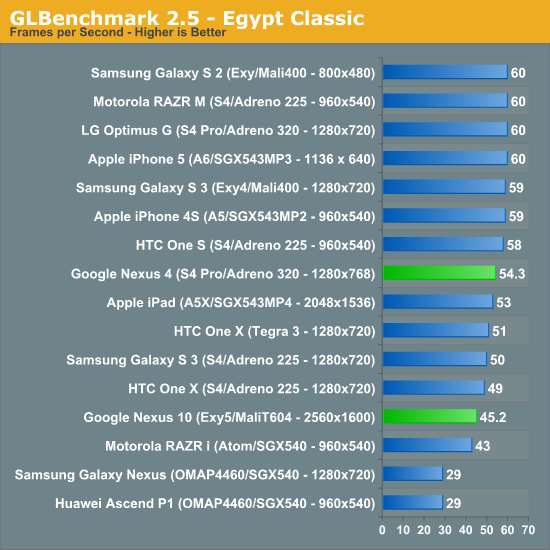
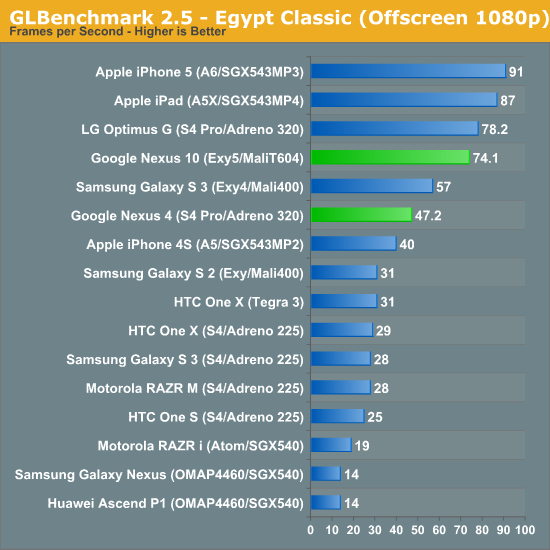
The Egypt Classic numbers are less interesting, but both platforms do well here.
Battery Life
We didn't have time to run through our entire battery life suite, but we do have some relevant results for the two devices. For smartphones, these are our latest web browsing battery life tests:
We regularly load web pages at a fixed interval until the battery dies (all displays are calibrated to 200 nits as always). The differences between this test and our previous one boil down to the amount of network activity and CPU load.
On the network side, we've done a lot more to prevent aggressive browser caching of our web pages. Some caching is important otherwise you end up with a baseband test, but it's clear what we had previously wasn't working. Brian made sure that despite the increased network load, the baseband still had the opportunity to enter its idle state during the course of the benchmark.
We also increased CPU workload along two vectors: we decreased pause time between web page loads and we shifted to full desktop web pages, some of which are very js heavy. The end result is a CPU usage profile that mimics constant, heavy usage beyond just web browsing. Everything you do on your smartphone ends up causing CPU usage peaks - opening applications, navigating around the OS and of course using apps themselves. Our 5th generation web browsing battery life test should map well to more types of smartphone usage, not just idle content consumption of data from web pages.
As always we test across multiple air interfaces (3G, 4G LTE, WiFi), but due to the increased network load we actually find that on a given process technology we see an increase in battery life on faster network connections. The why is quite simple to understand: the faster a page is able to fully render, the quicker all components can drive down to their idle power states.
All Android tests use Chrome and 5GHz WiFi unless otherwise listed.
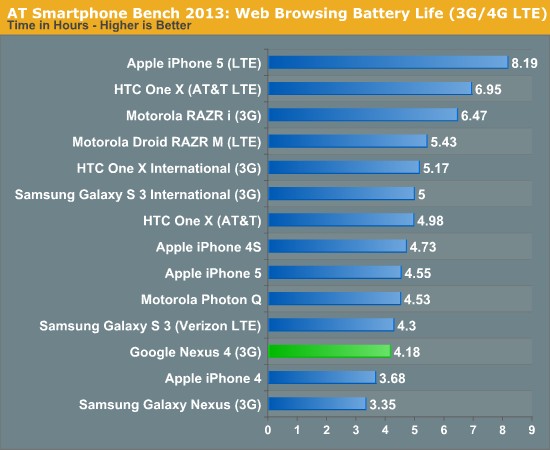
The Nexus 4 doesn't break any records for 3G battery life, it ends up relatively low on our list - even the Galaxy S 3 manages to do better here on 3G.

WiFi battery life is similar to the Galaxy S 3, but again it's not all that impressive compared to some of the other devices in this list.
Our tablet web browsing battery life test isn't directly comparable to the new smartphone tests, so we've got a separate chart for the Nexus 10:
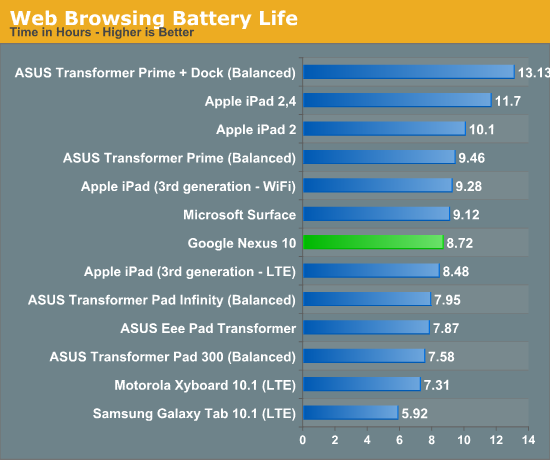
Despite driving a very high res panel, Google is able to deliver relatively competitive battery life with the Nexus 10. Battery capacity is around 80% the size of the 3rd gen iPad and battery life is around 93% of what Apple delivers here. Over 10 hours would be nice to have, but 8 hours of use in this test isn't bad at all. We'll have to do more testing to understand Exynos 5's power behavior a bit better, but so far it doesn't seem that the platform is all that bad from a power consumption standpoint. It remains to be seen how gracefully the Nexus 10 will handle being taxed heavier.
Display
We're still running our big display analysis routines on the new Nexus devices, but the brightness/contrast data below is a little teaser:
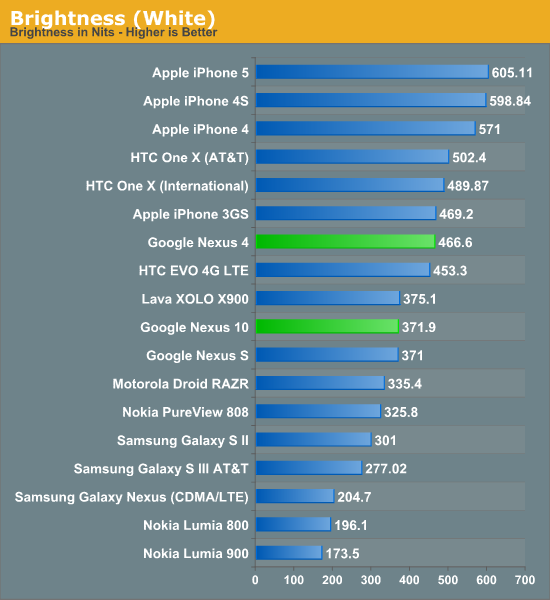
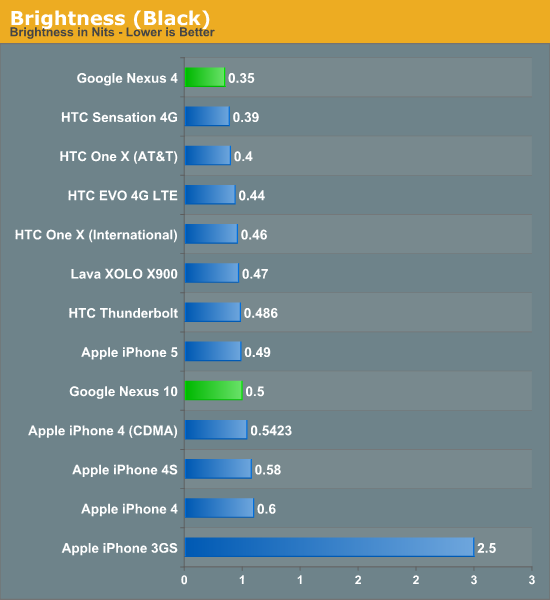
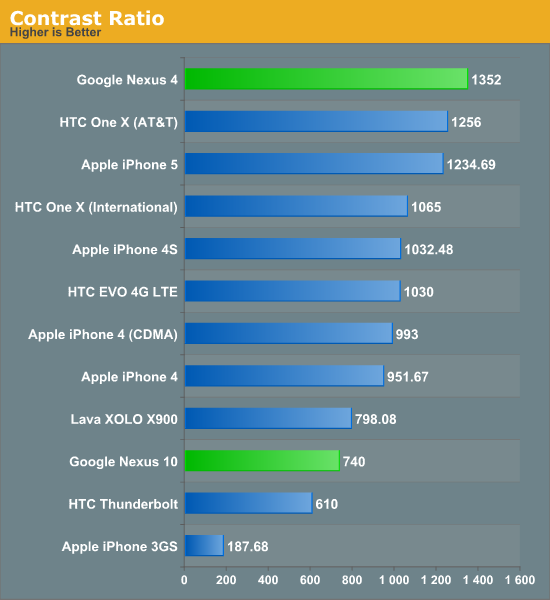
Final Words
We still have a lot of additional writing and testing ahead of us. Stay tuned for our full review of both devices!










244 Comments
View All Comments
Pipperox - Friday, November 2, 2012 - link
Well if you pay attention to this preview, you'll see that the numbers are rather inconsistent.The Snapdragon S4 Pro here basically gets beaten in several tests by its lesser sibling the Snapdragon S4; that doesn't make any sense.
There also seem to be obvious issues with the browser tests.
Maybe the SW is still not in final stage...
ratte - Friday, November 2, 2012 - link
As Anand& Brian said "there is some thermal throttling happening on the device."Pipperox - Friday, November 2, 2012 - link
They can say what they want, what I see in the number they've posted is that the LG Optimus G is mopping the floor with the Nexus 4.The funny thing is that the LG Optimus G is the SAME darn phone, with less built in flash and no SD card slot.
And it's also manufactured by LG as well.
So either they got a faulty sample, or perhaps LG is skimping on manufacturing quality for the phones they sell to Google?
Alexvrb - Saturday, November 3, 2012 - link
So you're saying that a company can't build two different devices of different quality levels? Off contract $550 phone vs a $300-350 phone, for example?Maybe... you know... you get what you pay for? There's more to a phone than what processor it uses? Things like build quality, LTE, storage, memory card slot... speaking of memory card slots, Apple and MS took a lot of flack for this. Where's all the naysayers now? Matias Duarte of Google says you're all too stupid to use memory cards, what do you have to say about that?
Slightly off topid: The line in the article was about Google pricing the Nexus 10 "aggressively" made me chuckle a bit. Mostly because the lack of a memory card slot was one of the things I hated about iDevices, and here's all these Nexus devices without a card slot. So now I'm looking at the 32GB model for $500 and thinking competing models look more appealing now. Well except for iPad, I still don't want one of those, even though the iPad 4 is a screamer.
De_Com - Monday, November 5, 2012 - link
Of course a company can build two different devices with differing build quality.There could be a myriad of reasons why the Optimus G looks so good in these tests, but as already stated above, there seems to be something else going on, which hopefully will be sorted before release.Apple and MS take a bashing for no SD Card Slot and rightly so in my opinion, they never offered one period, you can get other Android devices with an SD slot, that's the beauty of choice.
The fact that Google, one of, if not the biggest "Cloud" providers on the planet want to push devices with no SD doesn't seem in line with their business model to you??
They've gone aggressive on all Nexus devices, not just the 10", why do you think the 7" at $199 has been such a runaway success.
With the entry 10" at $399 for 16GB it's directly priced at iPad2 levels, given that choice it's a very tempting offer.
rdatoc - Friday, November 2, 2012 - link
Anand,Just want to give you a heads up that you might have another URL injecting bit of Javascript from one of your content partners (as happened with your Intel 330 SSD review back in August). I was redirected to:
http://testables.net/d/juicyru.com
from the first page of this article, congratulating me on getting a chance to win an iPad mini or a $1000 gift card. I don't see any embedded links in the text and i don't remember clicking on anything so it might just be my browser or PC ;-) but I am running Chrome and daily scans (which doesn't really count for much as it used to in this era of zero-day exploits).
firesyde424 - Friday, November 2, 2012 - link
This just happened to me as well when posting a comment.noblemo - Sunday, November 4, 2012 - link
Similar circumstance:From the page: http://www.anandtech.com/tag/smartphones
Clicking the link: "197 Comments" (http://www.anandtech.com/show/6425/google-nexus-4-...
Took me to: http://testables.net/d/juicyru.com, which displayed a full screen ad for Netflix.
edlee - Friday, November 2, 2012 - link
Ok, who cares for another tablet, I already have two in my home, dont use them nearly as much as my smartphone.So when is this beast called the exynos5dual coming to smartphones, I need this soc along with a 5" 1080p super freaking amoled hd plus (whatever moniker is for the non-pentile is called) screen.
bwmccann - Friday, November 2, 2012 - link
Anand and team. Please start reviewing tablets and comparing them to each other. I'd love to see the Surface models, Kindle HD models, IPADs, Nexus and Samsung devices pitted at each other. It would really help determine my next purchase.